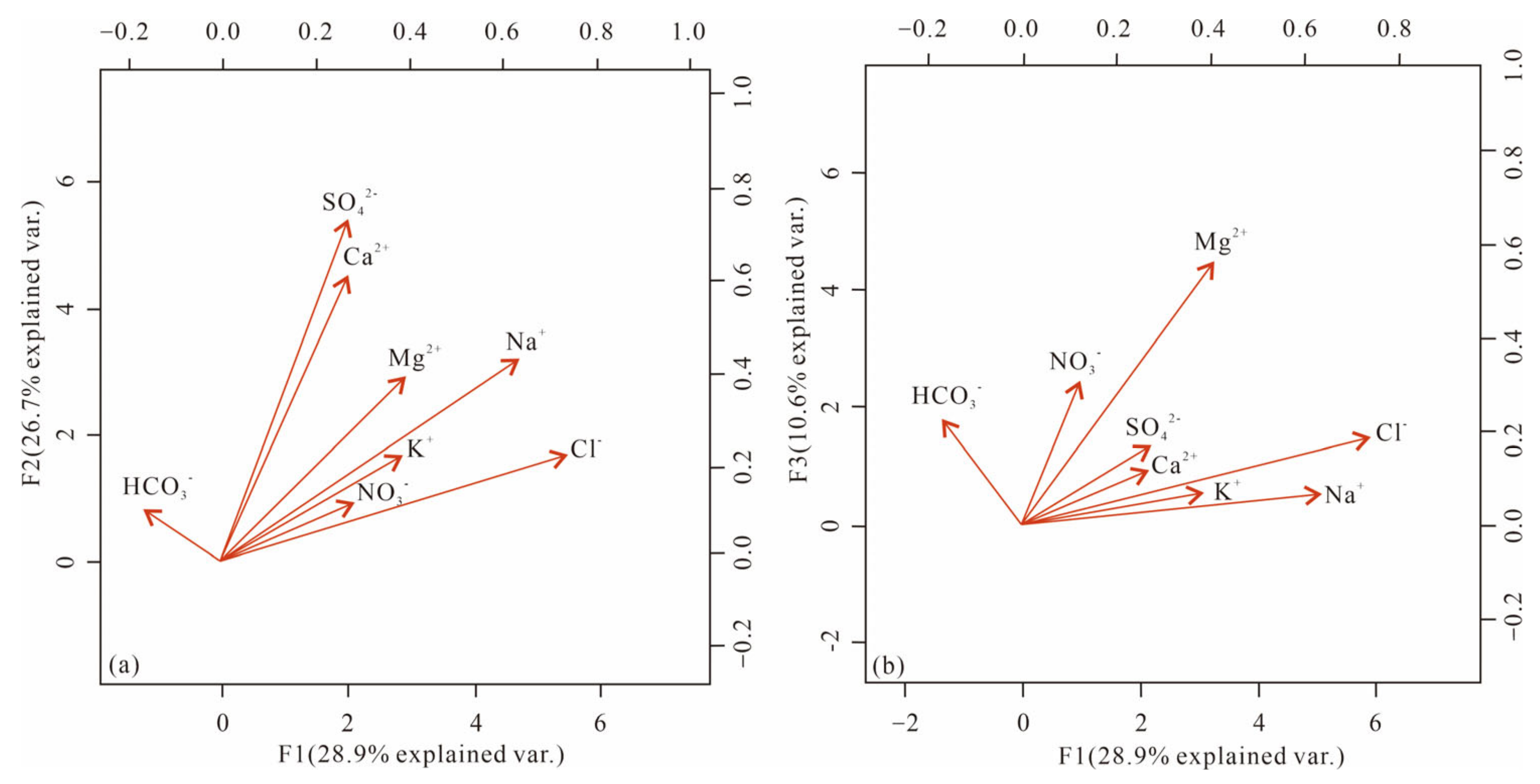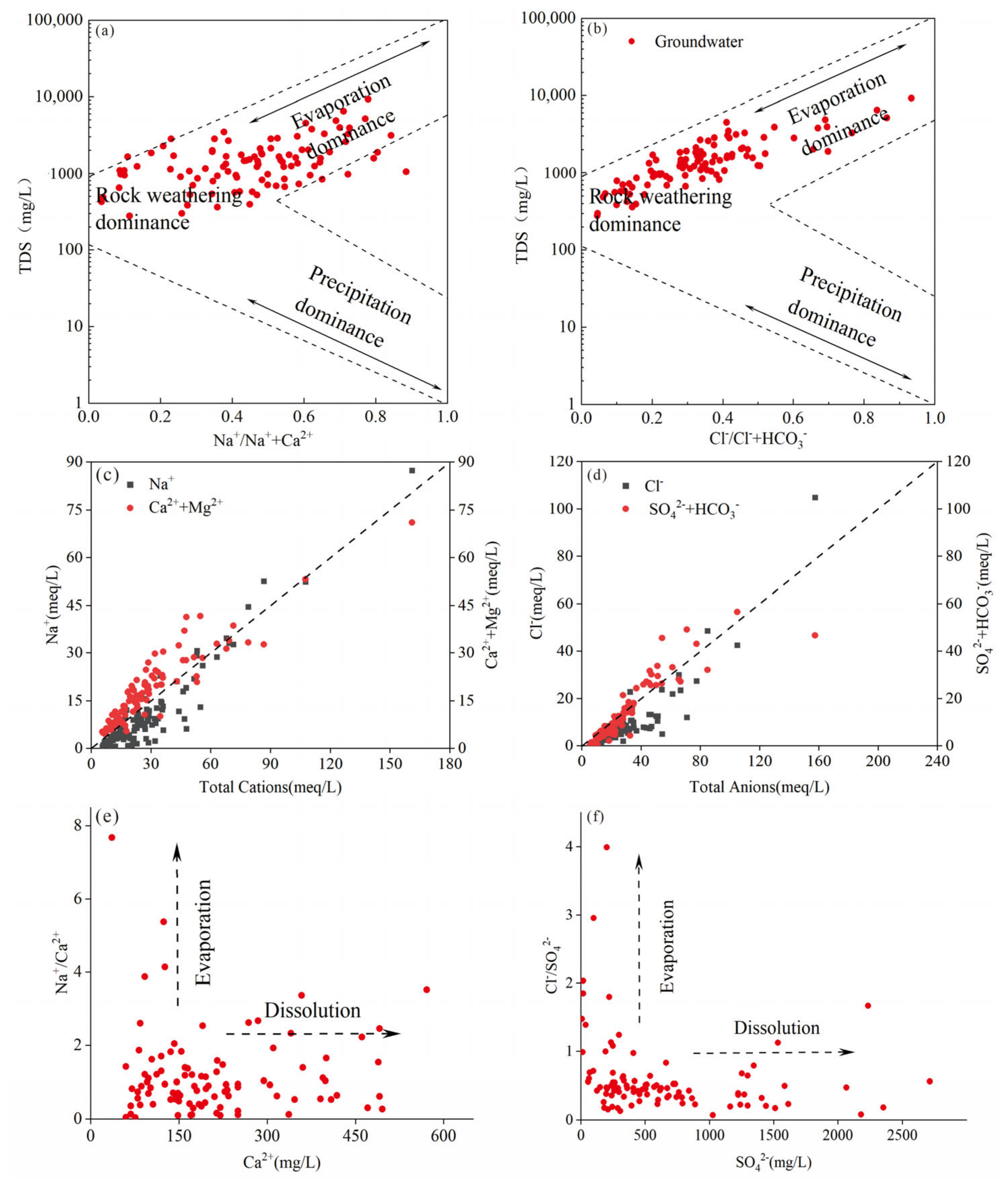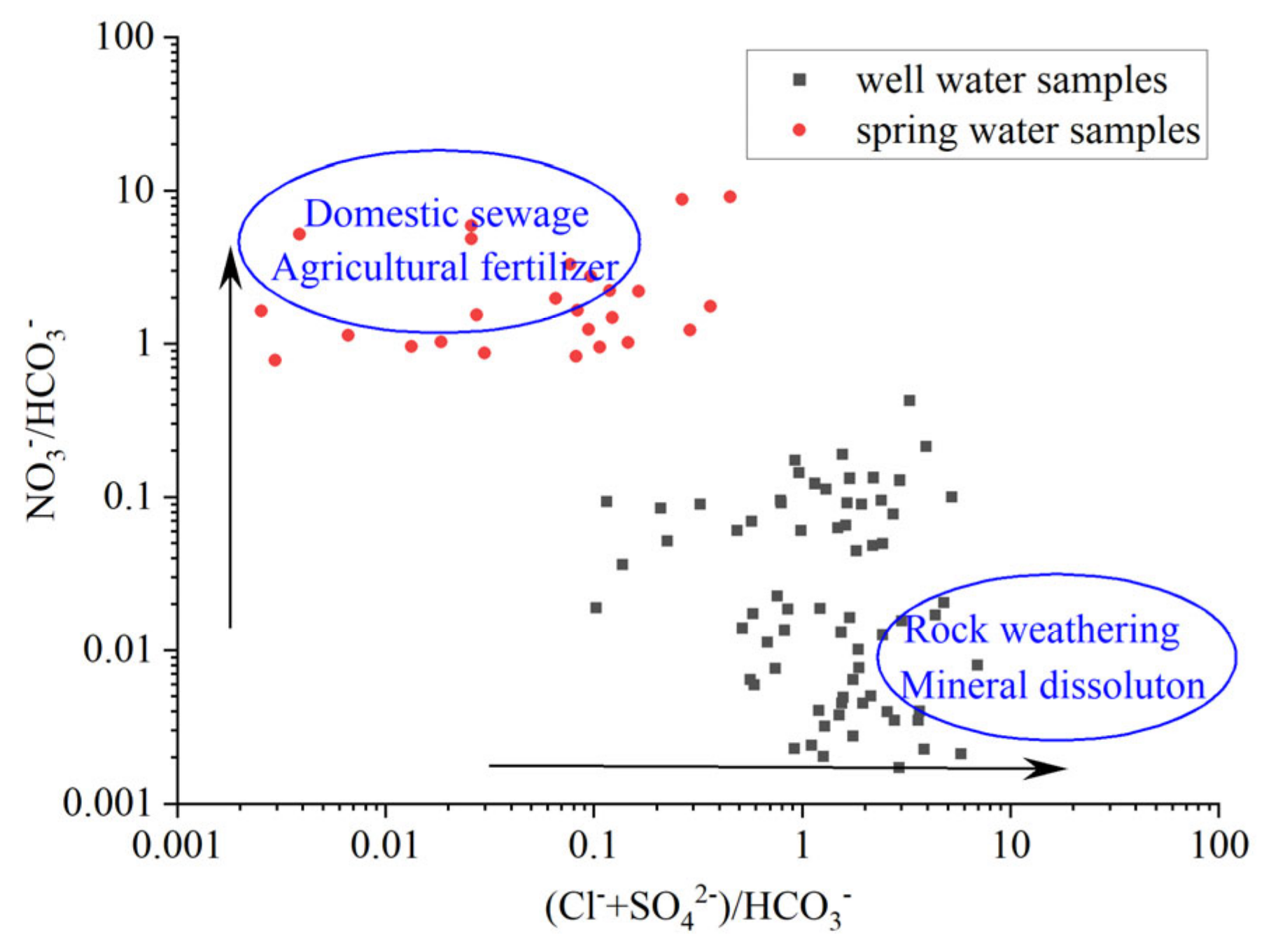Groundwater Nitrate Contamination in Arid Areas of Haidong
Abstract
:1. Introduction
2. Study Area
2.1. Physical Geography
2.2. Geological Conditions
2.3. Human Activities and Land Use
3. Materials and Methods
3.1. Sample Collection and Measurements
3.2. Correlation Analysis
3.3. Factor Analysis
4. Results and Discussion
4.1. Hydrochemical Characteristics
4.2. Result of Factor Analysis
4.3. Mechanism Controlling Water Chemistry
4.3.1. Rock Weathering
4.3.2. Evaporation
4.4. Analysis of the Origin of Nitrates
5. Conclusions
Author Contributions
Funding
Data Availability Statement
Conflicts of Interest
References
- Abbasnia, A.; Yousefi, N.; Mahvi, A.H.; Nabizadeh, R.; Radfard, M.; Yousefi, M.; Alimohammadi, M. Evaluation of groundwater quality using water quality index and its suitability for assessing water for drinking and irrigation purposes: Case study of Sistan and Baluchistan province (Iran). Hum. Ecol. Risk Assess. 2019, 25, 988–1005. [Google Scholar] [CrossRef]
- Li, R. Development and Performance Study of In-Situ Bioremediation Simulation Device for Nitrate Pollution in Groundwater; China University of Geosciences: Beijing, China, 2015. [Google Scholar]
- Qasemi, M.; Farhang, M.; Morovati, M.; Mahmoudi, M.; Ebrahimi, S.; Abedi, A.; Bagheri, J.; Zarei, A.; Bazeli, J.; Afsharnia, M.; et al. Investigation of potential human health risks from fluoride and nitrate via water consumption in Sabzevar, Iran. Int. J. Environ. Anal. Chem. 2022, 102, 307–318. [Google Scholar] [CrossRef]
- Xin, J.; Wang, Y.; Shen, Z.L.; Liu, Y.; Wang, H.T.; Zheng, X.L. Critical review of measures and decision support tools for groundwater nitrate management: A surface-to-groundwater profile perspective. J. Hydrol. 2021, 598, 126386. [Google Scholar] [CrossRef]
- Zhang, Q.Q.; Wang, H.W.; Wang, L. Tracing nitrate pollution sources and transformations in the over-exploited groundwater region of North China using stable isotopes. J. Contam. Hydrol. 2018, 218, 1–9. [Google Scholar] [CrossRef] [PubMed]
- Woodward, S.J.R.; Stenger, R.; Bidwell, V.J. Dynamic analysis of stream flow and water chemistry to infer subsurface water and nitrate fluxes in a lowland dairying catchment. J. Hydrol. 2013, 505, 299–311. [Google Scholar] [CrossRef]
- Sun, R.B.; Ding, J.K.; Li, H.Y.; Wang, X.G.; Li, W.; Li, K.X.; Ye, X.X.; Sun, S.Y. Mitigating nitrate leaching in cropland by enhancing microbial nitrate transformation through the addition of liquid biogas slurry. Agric. Ecosyst. Environ. 2023, 345, 108324. [Google Scholar] [CrossRef]
- Chen, R.D.; Hu, Q.H.; Shen, W.Q.; Guo, J.X.; Yang, L.; Yuan, Q.Q.; Lu, X.M.; Wang, L.C. Identification of nitrate sources of groundwater and rivers in complex urban environments based on isotopic and hydro-chemical evidence. Sci. Total Environ. 2023, 871, 162026. [Google Scholar] [CrossRef] [PubMed]
- Cao, X.; Shi, Y.Y.; Wei, H.; An, T.Y.; Chen, X.R.; Zhang, Z.H.; Liu, F.; Zhao, Y.; Zhou, P.P.; Chen, C.B.; et al. Impacts of anthropogenic groundwater recharge (AGR) on nitrate dynamics in a phreatic aquifer revealed by hydrochemical and isotopic technologies. Sci. Total Environ. 2022, 839, 156187. [Google Scholar] [CrossRef]
- Adimalla, N.; Qian, H. Groundwater chemistry, distribution and potential health risk appraisal of nitrate enriched groundwater: A case study from the semi-urban region of South India. Ecotoxicol. Environ. Saf. 2021, 207, 111277. [Google Scholar] [CrossRef]
- Gu, B.; Ge, Y.; Chang, S.; Luo, W.; Chang, J. Nitrate in groundwater of China: Sources and driving forces. Glob. Environ. Chang. Part A Hum. Policy Dimens. 2013, 23, 1112–1121. [Google Scholar] [CrossRef]
- Panahi, G.; Eskafi, M.H.; Rahimi, H.; Faridhosseini, A.; Tang, X.N. Physical–chemical evaluation of groundwater quality in semi-arid areas: Case study—Sabzevar plain, Iran. Sustain. Water Resour. Manag. 2021, 7, 2363–5037. [Google Scholar] [CrossRef]
- Zhai, Y.; Zheng, F.; Zhao, X.; Xia, X.; Teng, Y. Identification of hydrochemical genesis and screening of typical groundwater pollutants impacting human health: A case study in Northeast China (Article). Environ. Pollut. 2019, 252, 1202–1215. [Google Scholar] [CrossRef] [PubMed]
- He, S.; Wu, J.H.; Wang, D.; He, X.D. Predictive modeling of groundwater nitrate pollution and evaluating its main impact factors using random forest. Chemosphere 2022, 290, 133388. [Google Scholar] [CrossRef] [PubMed]
- Han, D.M.; Currell, M.J.; Cao, G.L. Deep challenges for China’s war on water pollution. Environ. Pollut. 2016, 218, 1222–1233. [Google Scholar] [CrossRef] [PubMed]
- Kazakis, N.; Voudouris, K.S. Groundwater vulnerability and pollution risk assessment of porous aquifers to nitrate: Modifying the DRASTIC method using quantitative parameters. J. Hydrol. 2015, 525, 13–25. [Google Scholar] [CrossRef]
- Wang, C.; Wang, X.; Zhang, G.; Zhang, F.; Li, J.; Chen, S.; Sauvage, S.; Sánchez-Pérez, J.-M.; Han, Y.; Liu, J. Identification of critical effect factors for prediction of spatial and intra-annual variability of shallow groundwater nitrate in agricultural areas. Sci. Total Environ. 2023, 891, 164342. [Google Scholar] [CrossRef] [PubMed]
- Wang, D.; Li, P.; Mu, D.; Liu, W.; Chen, Y.; Fida, M. Unveiling the biogeochemical mechanism of nitrate in the vadose zone-groundwater system: Insights from integrated microbiology, isotope techniques, and hydrogeochemistry. Sci. Total Environ. 2023, 906, 167481. [Google Scholar] [CrossRef] [PubMed]
- Feng, W.W.; Wang, C.; Lei, X.H.; Wang, H.; Zhang, X.L. Distribution of nitrate content in groundwater and evaluation of potential health risks: A case study of rural areas in northern China. Int. J. Environ. Res. Public Health 2020, 17, 9390. [Google Scholar] [CrossRef]
- Liu, L.N.; Wu, J.H.; He, S.; Wang, L. Occurrence and distribution of groundwater fluoride and manganese in the Weining Plain (China) and their probabilistic health risk quantification. Expo. Health 2022, 14, 263–279. [Google Scholar] [CrossRef]
- Tang, W.Z.; Pei, Y.S.; Zheng, H.; Zhao, Y.; Shu, L.M.; Zhang, H. Twenty years of China’s water pollution control: Experiences and challenges. Chemosphere 2022, 295, 133875. [Google Scholar] [CrossRef]
- Wen, X.H.; Feng, Q.; Lu, J.; Wu, J.; Wu, M.; Guo, X.Y. Risk assessment and source identification of coastal groundwater nitrate in northern China using dual nitrate isotopes combined with Bayesian mixing model. Hum. Ecol. Risk Assess. 2018, 24, 1043–1057. [Google Scholar] [CrossRef]
- Wu, J.; Zhao, W.D.; Lu, J.; Jin, S.; Wang, J.Q.; Qian, J.Z. Geographic information system based approach for the investigation of groundwater nitrogen pollution near a closed old landfill site in Beijing, China. Environ. Eng. Manag. J. 2018, 17, 1095–1101. [Google Scholar]
- Zhang, X.; Zhang, Y.; Shi, P.; Bi, Z.L.; Shan, Z.X.; Ren, L.J. The deep challenge of nitrate pollution in river water of China. Sci. Total Environ. 2021, 770, 144674. [Google Scholar] [CrossRef]
- Wang, M.; Janssen, A.B.G.; Bazin, J.; Strokal, M.; Ma, L.; Kroeze, C. Accounting for interactions between Sustainable Development Goals is essential for water pollution control in China. Nat. Commun. 2022, 13, 730. [Google Scholar] [CrossRef]
- Dragon, K.; Gorski, J. Identification of groundwater chemistry origins in a regional aquifer system (Wielkopolska region, Poland). Environ. Earth Sci. 2015, 73, 2153–2167. [Google Scholar] [CrossRef]
- Xiao, Y.; Liu, K.; Hao, Q.C.; Xiao, D.; Zhu, Y.C.; Yin, S.Y.; Zhang, Y.H. Hydrogeochemical insights into the signatures, genesis and sustainable perspective of nitrate enriched groundwater in the piedmont of Hutuo watershed, China. Catena 2022, 212, 106020. [Google Scholar] [CrossRef]
- Erostate, M.; Huneau, F.; Garel, E.; Lehmann, M.F.; Kuhn, T.; Aquilina, L.; Vergnaud-Ayraud, V.; Labasque, T.; Santoni, S.; Robert, S.; et al. Delayed nitrate dispersion within a coastal aquifer provides constraints on land-use evolution and nitrate contamination in the past. Sci. Total Environ. 2018, 644, 928–940. [Google Scholar] [CrossRef] [PubMed]
- Nestler, A.; Berglund, M.; Accoe, F.; Duta, S.; Xue, D.; Boeckx, P.; Taylor, P. Isotopes for improved management of nitrate pollution in aqueous resources: Review of surface water field studies. Environ. Sci. Pollut. Res. 2011, 18, 519–533. [Google Scholar] [CrossRef] [PubMed]
- Taufiq, A.; Effendi, A.J.; Iskandar, I. Controlling factors and driving mechanisms of nitrate contamination in groundwater system of Bandung Basin, Indonesia, deduced by combined use of stable isotope ratios, CFC age dating, and socioeconomic parameters. Water Res. 2019, 148, 292–305. [Google Scholar] [CrossRef] [PubMed]
- Lahjouj, A.; El Hmaidi, A.; Bouhafa, K. Spatial and statistical assessment of nitrate contamination in groundwater: Case of sais basin, Morocco. J. Groundw. Sci. Eng. 2020, 8, 143–157. [Google Scholar]
- Wang, D.; Zhang, L.; Pei, L.; Li, X.; Yang, Y.; Chen, Z.; Liang, L. Chemical Characteristics and Controlling Factors of Shallow Groundwater in the Lower Reaches of Changhua River Basin, Hainan Island, China. Water 2023, 15, 3508. [Google Scholar] [CrossRef]
- Jiao, Z.R. Research on Evolution of Groundwater Chemical Characteristics of Ledu Basin in the Eastern Qinhai Province; Hebei University of Geosciences: Shijiazhuang, China, 2018. [Google Scholar]
- Liu, Q. The Groundwater Chemical Characteristics in Ping′an Basin in East Qinghai Province; Hebei University of Geosciences: Shijiazhuang, China, 2018. [Google Scholar]
- Su, H.; Kang, W.D.; Li, Y.R.; Li, Z. Fluoride and nitrate contamination of groundwater in the Loess Plateau, China: Sources and related human health risks. Environ. Pollut. 2021, 286, 117287. [Google Scholar] [CrossRef] [PubMed]
- Farnham, I.M.; Johannesson, K.H.; Singh, A.K.; Hodge, V.F.; Stetzenbach, K.J. Factor analytical approaches for evaluating groundwater trace element chemistry data. Anal. Chim. Acta 2003, 490, 123–138. [Google Scholar] [CrossRef]
- GB 5749-2022; Standards for Drinking Water Quality. Standardization Administration of the People’s Republic of China: Beijing, China, 2022.
- Gibbs, R.J. Mechanisms controlling world water chemistry. Science 1970, 170, 1088–1090. [Google Scholar] [CrossRef]
- Saikrishna, K.; Purushotham, D.; Sunitha, V.; Reddy, Y.S.; Brahmaiah, T.; Reddy, B.M.; Nallusamy, B. Deciphering groundwater quality, mechanisms controlling groundwater chemistry in and around Suryapet, Telangana, South India. Total Environ. Res. Themes 2023, 6, 100035. [Google Scholar] [CrossRef]
- Zhang, H.Y.; Han, X.; Wang, G.C.; Mao, H.R.; Chen, X.L.; Zhou, L.; Huang, D.D.; Zhang, F.; Yan, X. Spatial distribution and driving factors of groundwater chemistry and pollution in an oil production region in the Northwest China. Sci. Total Environ. 2023, 875, 162635. [Google Scholar] [CrossRef]








| Parameters | Units | Maximum | Minimum | Mean | Median | CV | Standard 2 | |||||
|---|---|---|---|---|---|---|---|---|---|---|---|---|
| GW 1 | SW | GW | SW | GW | SW | GW | SW | GW | SW | |||
| Na+ | mg/L | 2008.6 | 476.3 | 2.54 | 4.04 | 249.2 | 157.8 | 159.4 | 81.1 | 122.1% | 95.5% | 200 |
| K+ | mg/L | 168.9 | 56.3 | 0 | 0 | 21.9 | 13.2 | 9.9 | 5.1 | 144% | 130.4% | / |
| Ca2+ | mg/L | 571.1 | 288.58 | 36.1 | 52.1 | 211.3 | 128.4 | 180.4 | 91.2 | 57.6% | 58.3% | / |
| Mg2+ | mg/L | 509.1 | 104.49 | 0 | 15.8 | 92.5 | 53.3 | 76.6 | 45.6 | 78.9% | 61.1% | / |
| Cl− | mg/L | 3722.3 | 506.94 | 14.2 | 10.64 | 308.1 | 168.4 | 198.5 | 85.1 | 146.3% | 100.1% | 250 |
| SO42− | mg/L | 2713.7 | 1068.7 | 9.6 | 38.42 | 636.1 | 389.8 | 446.7 | 266.6 | 90.4% | 88.9% | 250 |
| HCO3− | mg/L | 689.5 | 378.32 | 203.6 | 201.37 | 403.6 | 267.5 | 408.8 | 256.3 | 24.2% | 18.3% | / |
| NO3− | mg/L | 301.1 | 77.96 | 0 | 5.39 | 29.3 | 21.1 | 11.3 | 15.4 | 147.8% | 89.8% | 44.3 |
| pH | / | 8.3 | 8.26 | 7.01 | 7.21 | 7.5 | 7.9 | 7.5 | 8.1 | 3.45% | 4.3% | 6.5–8.5 |
| TDS | mg/L | 9235.5 | 2346.6 | 278.1 | 235.29 | 1714.3 | 1032.8 | 1349 | 698.2 | 80.6% | 75.8% | 1000 |
| TH | mg/L | 3522.8 | 1105.9 | 230.2 | 210.17 | 909.5 | 540 | 840.7 | 445.4 | 60.8% | 57% | 450 |
| T | °C | 25.5 | 15 | 0.9 | 6 | 10.5 | 9.31 | 10.7 | 8.65 | 40.5% | 32.1% | / |
| Original Variable | Load of Each Principal Component Variable | ||
|---|---|---|---|
| F1 | F2 | F3 | |
| Na+ | 0.801 | 0.541 | 0.000 |
| K+ | 0.486 | 0.284 | 0.000 |
| Ca2+ | 0.342 | 0.767 | 0.145 |
| Mg2+ | 0.513 | 0.490 | 0.701 |
| Cl− | 0.929 | 0.281 | 0.229 |
| SO42− | 0.344 | 0.913 | 0.209 |
| HCO3− | −0.211 | 0.144 | 0.282 |
| NO3− | 0.157 | 0.000 | 0.380 |
| Eigenvalue | 2.311 | 2.140 | 0.846 |
| Contribution of variance/% | 28.9 | 26.7 | 10.6 |
| Cumulative contribution/% | 28.9 | 55.6 | 66.2 |
| Index | Na+ | K+ | Ca2+ | Mg2+ | Cl− | SO42− | HCO3− | NO3− |
|---|---|---|---|---|---|---|---|---|
| Na+ | 1 | |||||||
| K+ | 0.5756 | 1 | ||||||
| Ca2+ | 0.5999 | 0.3543 | 1 | |||||
| Mg2+ | 0.7325 | 0.4487 | 0.6499 | 1 | ||||
| Cl− | 0.9154 | 0.5499 | 0.5738 | 0.7752 | 1 | |||
| SO42− | 0.7879 | 0.4445 | 0.8524 | 0.7706 | 0.6240 | 1 | ||
| HCO3− | 0.0002 | 0.0176 | 0.1684 | 0.1604 | −0.0965 | 0.1136 | 1 | |
| NO3− | 0.2418 | 0.1943 | 0.2161 | 0.3844 | 0.2519 | 0.1992 | 0.3879 | 1 |
Disclaimer/Publisher’s Note: The statements, opinions and data contained in all publications are solely those of the individual author(s) and contributor(s) and not of MDPI and/or the editor(s). MDPI and/or the editor(s) disclaim responsibility for any injury to people or property resulting from any ideas, methods, instructions or products referred to in the content. |
© 2023 by the authors. Licensee MDPI, Basel, Switzerland. This article is an open access article distributed under the terms and conditions of the Creative Commons Attribution (CC BY) license (https://creativecommons.org/licenses/by/4.0/).
Share and Cite
Liang, L.; Zhang, L.; Liu, C.; Zhu, J.; Wang, D. Groundwater Nitrate Contamination in Arid Areas of Haidong. Water 2023, 15, 4067. https://doi.org/10.3390/w15234067
Liang L, Zhang L, Liu C, Zhu J, Wang D. Groundwater Nitrate Contamination in Arid Areas of Haidong. Water. 2023; 15(23):4067. https://doi.org/10.3390/w15234067
Chicago/Turabian StyleLiang, Linde, Lizhong Zhang, Changli Liu, Jixiang Zhu, and Dun Wang. 2023. "Groundwater Nitrate Contamination in Arid Areas of Haidong" Water 15, no. 23: 4067. https://doi.org/10.3390/w15234067





